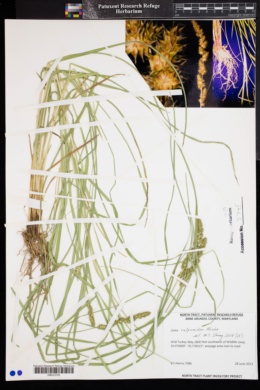Carex vulpinoidea
|
|
|
|
Family: Cyperaceae
Common Fox Sedge, more...fox sedge
[Carex scabrior Sartwell ex Boott, moreCarex vulpinoidea var. segregata , Carex vulpinoidea var. setacea (Dewey) Kük.] |
Culms to 100 cm × 2 mm, scabrous. Leaves: sheath fronts spotted red-brown or pale brown, apex truncate or short-convex, membranous or hyaline, rugose; ligule retuse or rounded, to 2 mm, free limb to 0.2 mm; blades 120 cm × 5 mm, longer than flowering stem. Inflorescences spicate, (3-)7-10 cm × 15 mm, with 10-15 branches, the proximal branches distinctly separate; the proximal internode to 25 mm; bracts setaceous, those subtending at least the proximal lateral branches conspicuous. Scales pale brown, hyaline, awn to 3 mm. Perigynia green to pale brown, veinless on both faces or 3-veined abaxially, body ovate or elliptic, 2-3.2 × 1.3-1.8 mm, base obtuse; beak 0.8-1.2 mm, 1/3-1/2 length of perigynium. Achenes red-brown, ovate, 1.2-1.4 × 1 mm, glossy. 2n = 52. Fruiting Jul-Aug. Seasonally saturated or inundated soils in open habitats, wet meadows, marshes, roadside ditches; 0-1800 m; St. Pierre and Miquelon; Alta., B.C., Man., N.B., Nfld. and Labr., N.S., Ont., P.E.I., Que., Sask.; Ala., Ariz., Ark., Calif., Colo., Conn., Del., D.C., Fla., Ga., Idaho, Ill., Ind., Iowa, Kans., Ky., La., Maine, Md., Mass., Mich., Minn., Miss., Mo., Nebr., N.H., N.J., N.Mex., N.Y., N.C., N.Dak., Ohio, Okla., Oreg., Pa., R.I., S.C., S.Dak., Tenn., Tex., Vt., Va., Wash., W.Va., Wis., Wyo.; Mexico (Sonora); introduced to Europe; New Zealand. Carex vulpinoidea is widely distributed in North America and frequently grows as a weed in wet roadside ditches and fields. It is quite variable, particularly in the degree to which the spongy tissue lateral to the achene is developed. The development of that tissue determines the shape of the perigynium and the degree to which the perigynium appears to contract into the achene, as discussed by F. M. B. Boott (1858-1867). The flowering stems shorter than the leaves, the pale brown, elliptic perigynia, and the preference for moist substrates of C. vulpinoidea readily distinguish it from C. annectens.
Stems stout, clustered, 3-10 dm, aphyllopodic; lvs scattered along the lower half or two-thirds of the stem, flat or nearly so, 2-5 mm wide; ventral side of the sheaths sparsely red- dotted and usually conspicuously cross-rugulose; spikes androgynous, numerous, sessile, small, few-fld, densely aggregated into an often irregular or interrupted infl that is 5-10 cm long, to 1.5 cm wide, and generally compound at least toward the base; upper spikes hardly distinguishable; bracts small, setaceous, only the lower ones sometimes elongate to 5 cm; pistillate scales slender, the firm midrib excurrent as an often greenish awn 1-5 mm; perigynia flattened or planoconvex, ±stramineous to light brown or partly greenish, 2-3.5 mm, the body narrowly ovate to rotund-ovate, nerveless or inconspicuously few-nerved, serrulate-margined distally; achene lenticular; 2n=52. In marshes and other wet low places; Nf. to Fla., w. to B.C., Wash., and Ariz. The widespread var. vulpinoidea usually has the lvs surpassing the stems; the perigynium tapers into a prominent beak sometimes as long as the body. (C. setacea) The var. ambigua Boott, mainly in our coastal states, but also inland nearly throughout our range, has the lvs mostly surpassed by the stems; the relatively broad perigynia are more abruptly contracted to the short beak to half as long as the body. (C. annectens) Gleason, Henry A. & Cronquist, Arthur J. 1991. Manual of vascular plants of northeastern United States and adjacent Canada. lxxv + 910 pp. ©The New York Botanical Garden. All rights reserved. Used by permission. From Flora of Indiana (1940) by Charles C. Deam One of the commonest sedges of swampy places throughout the state. Its favorite habitat is in roadside ditches but it is found also in marshes, swamps, low open woods, and ravines, on flood plains, and banks of streams and ponds. ...... Indiana Coefficient of Conservatism: C = 2 Wetland Indicator Status: OBL |
|
|
|




































































































